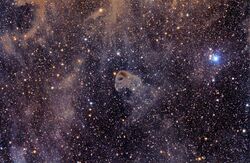Astronomy:41 Tauri
| Observation data Equinox J2000.0]] (ICRS) | |
|---|---|
| Constellation | Taurus |
| Right ascension | 04h 06m 36.413s[1] |
| Declination | +27° 35′ 59.64″[1] |
| Apparent magnitude (V) | 5.19[2] |
| Characteristics | |
| Spectral type | B9 p Si[3] |
| U−B color index | −0.47[2] |
| B−V color index | −0.12[2] |
| Variable type | α2 CVn[4] |
| Astrometry | |
| Radial velocity (Rv) | −2.0[5] km/s |
| Proper motion (μ) | RA: +21.153[1] mas/yr Dec.: −51.792[1] mas/yr |
| Parallax (π) | 8.0667 ± 0.1063[1] mas |
| Distance | 404 ± 5 ly (124 ± 2 pc) |
| Orbit[6] | |
| Period (P) | 7.2274 d |
| Eccentricity (e) | 0.18 |
| Semi-amplitude (K1) (primary) | 16.60 km/s |
| Details | |
| Mass | 2.9[6] M☉ |
| Radius | 3.54[7] R☉ |
| Luminosity | 190[8] L☉ |
| Surface gravity (log g) | 3.87[9] cgs |
| Temperature | 12,600[9] K |
| Metallicity [Fe/H] | 0.43[9] dex |
| Rotational velocity (v sin i) | 23[10] km/s |
| Age | 146[11] Myr |
| Other designations | |
| Database references | |
| SIMBAD | data |
41 Tauri is a single-lined spectroscopic binary system in the zodiacal constellation of Taurus; 41 Tauri is its Flamsteed designation. The star has a visual magnitude of 5.19,[2] making it visible to the naked eye from brighter suburban skies (according to the Bortle scale). Parallax measurements put it at a distance of roughly 404 light years from the Sun.[1]

This is a chemically peculiar star and was first classified as a silicon star by American astronomer William Morgan in 1933. The stellar spectrum displays an overabundance of heavier elements; particularly silicon and gallium.[9] These abundances may be caused by the magnetic field of the star, which produces concentrations of the observed elements in the outer atmosphere.[14] It is an α² Canum Venaticorum-type variable star, ranging in magnitude from 5.15 down to 5.22. These variations are likely due to large spots or rings on the side of the star being observed.[4]
The star and its companion orbit each other closely with a period of a week and an eccentricity of 0.18. The rotation period of the primary star has become locked to its orbit, so that one face is always pointed toward its companion. The abundance of gallium and silicon varies in a sinusoidal pattern that matches this period.[14]
The primary has around 2.9 times the mass of the Sun,[6] 3.5 times the Sun's radius,[7] and is emitting 190 times the luminosity of the Sun.[8] The effective temperature of the star's photosphere is 12,600 K,[9] giving it the blue-white hue of a B-type star.[15]
References
- ↑ 1.0 1.1 1.2 1.3 1.4 Vallenari, A. et al. (2022). "Gaia Data Release 3. Summary of the content and survey properties". Astronomy & Astrophysics. doi:10.1051/0004-6361/202243940 Gaia DR3 record for this source at VizieR.
- ↑ 2.0 2.1 2.2 2.3 Mermilliod, J.-C. (1986), "Compilation of Eggen's UBV data, transformed to UBV (unpublished)", Catalogue of Eggen's UBV Data. SIMBAD, Bibcode: 1986EgUBV........0M.
- ↑ Cowley, A. et al. (April 1969), "A study of the bright A stars. I. A catalogue of spectral classifications", Astronomical Journal 74: 375–406, doi:10.1086/110819, Bibcode: 1969AJ.....74..375C.
- ↑ 4.0 4.1 Kukarkin, B. V. et al. (1971), General Catalogue of Variable Stars (3rd ed.), Bibcode: 1971GCVS3.C......0K.
- ↑ Wilson, R. E. (1953), "General Catalogue of Stellar Radial Velocities", Carnegie Institute Washington D.C. Publication (Washington, D. C.: Carnegie Institute of Washington.), Bibcode: 1953GCRV..C......0W.
- ↑ 6.0 6.1 6.2 Ducati, J. R. et al. (January 2011), "The mass ratio and initial mass functions in spectroscopic binaries", Astronomy and Astrophysics 525: 9, doi:10.1051/0004-6361/200913895, A26, Bibcode: 2011A&A...525A..26D.
- ↑ 7.0 7.1 Shulyak, D. et al. (September 2014), "Interferometry of chemically peculiar stars: theoretical predictions versus modern observing facilities", Monthly Notices of the Royal Astronomical Society 443 (2): 1629–1642, doi:10.1093/mnras/stu1259, Bibcode: 2014MNRAS.443.1629S.
- ↑ 8.0 8.1 McDonald, I. et al. (2012), "Fundamental Parameters and Infrared Excesses of Hipparcos Stars", Monthly Notices of the Royal Astronomical Society 427 (1): 343–57, doi:10.1111/j.1365-2966.2012.21873.x, Bibcode: 2012MNRAS.427..343M.
- ↑ 9.0 9.1 9.2 9.3 9.4 Bolcal, C. et al. (December 1987), "A model atmosphere analysis of HD 25823", Astrophysics and Space Science 139 (2): 295–304, doi:10.1007/BF00644358, Bibcode: 1987Ap&SS.139..295B.
- ↑ Freire Ferrero, R. et al. (February 2012), "High Ionization Species in the Nearby Interstellar Medium from an Exhaustive Analysis of the IUE INES Database", The Astronomical Journal 143 (2): 38, doi:10.1088/0004-6256/143/2/28, 28, Bibcode: 2012AJ....143...28F.
- ↑ Gontcharov, G. A. (2012), "Dependence of kinematics on the age of stars in the solar neighborhood", Astronomy Letters 38 (12): 771–782, doi:10.1134/S1063773712120031, Bibcode: 2012AstL...38..771G.
- ↑ "41 Tau". SIMBAD. Centre de données astronomiques de Strasbourg. http://simbad.u-strasbg.fr/simbad/sim-basic?Ident=41+Tau.
- ↑ MAST: Barbara A. Mikulski Archive for Space Telescopes, Space Telescope Science Institute, https://mast.stsci.edu/portal/Mashup/Clients/Mast/Portal.html, retrieved 8 December 2021.
- ↑ 14.0 14.1 Artru, M.-C.; Freire-Ferrero, R. (September 1988), "Line variations in the ultra-violet spectrum of the Ap-Si star HD 25823", Astronomy and Astrophysics 203 (1): 111–116, Bibcode: 1988A&A...203..111A.
- ↑ "The Colour of Stars", Australia Telescope, Outreach and Education (Commonwealth Scientific and Industrial Research Organisation), December 21, 2004, http://outreach.atnf.csiro.au/education/senior/astrophysics/photometry_colour.html, retrieved 2012-01-16.
 |


